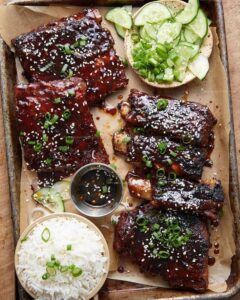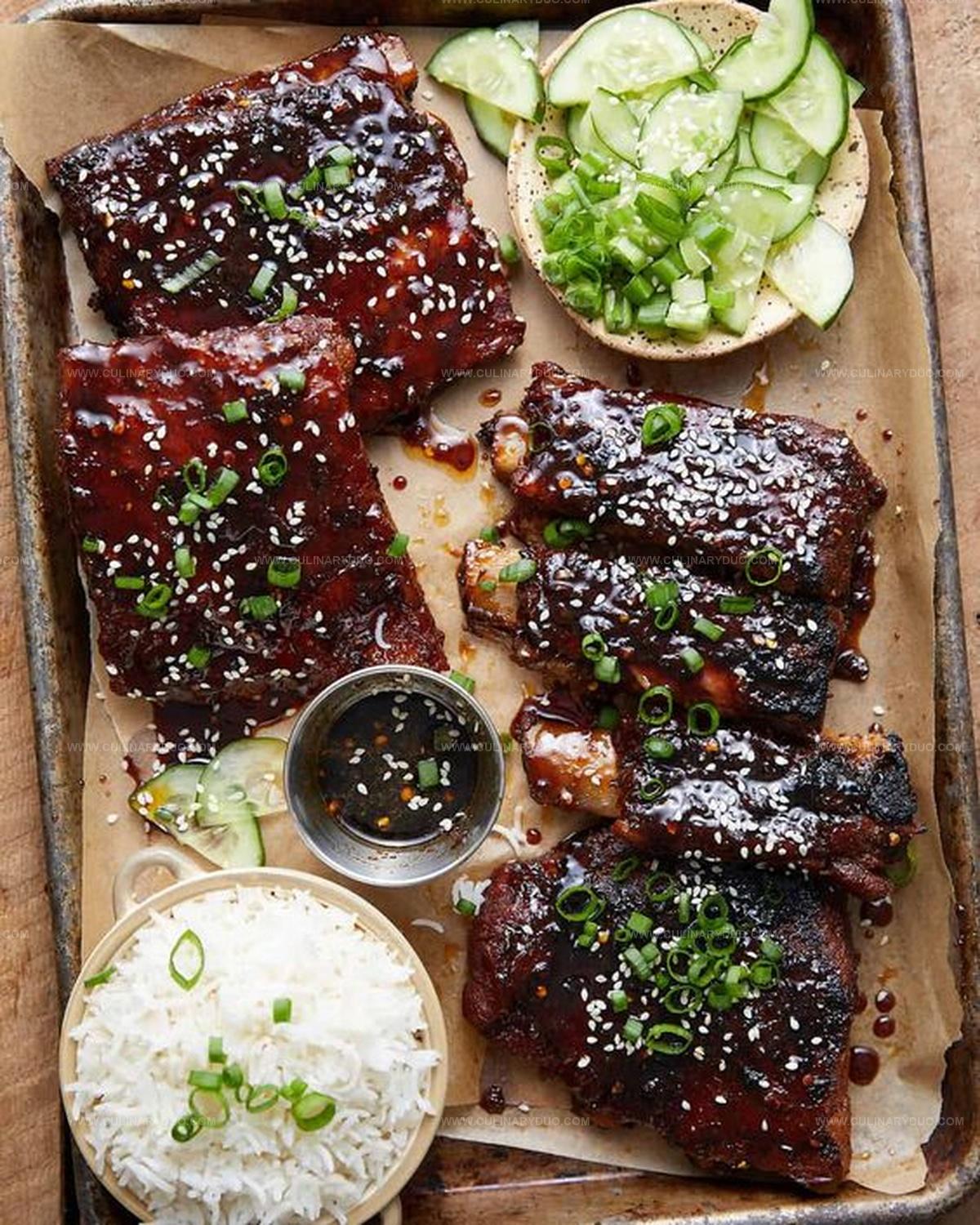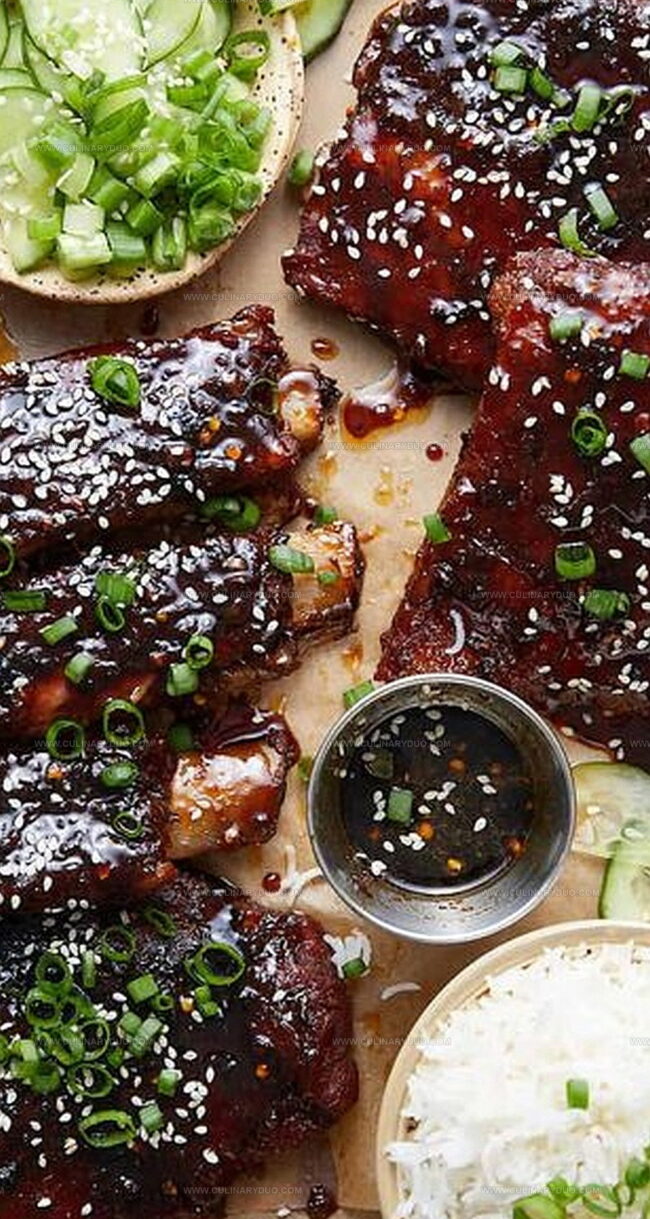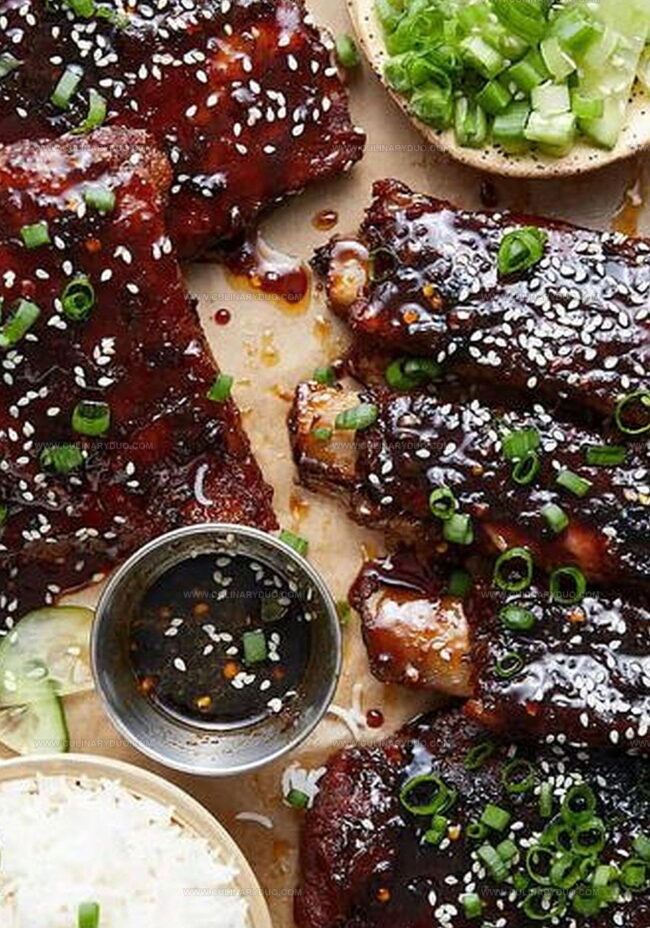Sizzling Sticky Asian Pork Ribs Recipe: Caramelized Perfection
Sticky asian pork ribs dance between sweet and savory, promising a culinary adventure that’ll make your taste buds sing.
Tender meat falls deliciously off the bone with minimal effort.
Marinades packed with umami flavors create magic in your kitchen.
Tangy ingredients like soy sauce and honey mingle perfectly in this simple recipe.
Weeknight dinners suddenly feel special when these ribs emerge from the oven.
Complex flavors emerge from surprisingly straightforward preparation techniques.
Succulent and glossy, these ribs will become your new go-to meal that impresses everyone around the table.
Sticky Asian Pork Ribs Overview
Ingredients for Sticky Asian Ribs
Main Ingredients:
Pork Ribs: A tender and flavorful cut of meat that serves as the star of this delicious Asian-inspired dish.
Seasoning Blend:Glaze Ingredients:How to Prepare Sticky Asian Pork Ribs
Step 1: Prepare the Oven and Ribs
Crank up your oven to 275 degrees.
Using a sharp paring knife, carefully remove the silvery membrane from the back of the ribs.
Pull it off with your fingers after loosening it.
Slice the ribs into 3-4 portions and pat them completely dry with a paper towel.
Step 2: Create Flavor-Packed Rub
Mix together a powerful blend of seasonings:Coat every inch of the ribs thoroughly with this aromatic rub.
Step 3: Wrap and Slow Roast
Wrap each rib portion tightly in aluminum foil.
Place the wrapped ribs on a large baking sheet.
Roast baby back ribs for 2-2.5 hours, or St.
Louis-style ribs for 2.5-3 hours.
Step 4: Craft Sticky Glaze
In a saucepan, heat sesame oil over medium-low heat.
Toss in:Sauté until wonderfully fragrant.
Add:Bring to a boil, stirring constantly.
Reduce for 5-7 minutes until the sauce thickens beautifully.
Step 5: Caramelize and Finish
Unwrap the ribs, exposing the tops.
Brush generously with the sticky glaze.
Broil on high for 2-3 minutes, watching carefully to achieve a perfect light char.
Slice into individual ribs and serve with extra sauce on the side.
Pro Tips:Bonus Serving Suggestion: Leftover rib meat makes amazing tacos, sandwiches, or can be transformed into delicious fried rice the next day.
Pro Secrets for Perfect Asian Ribs
Flavorful Variations for Asian Pork Ribs
Serving Suggestions for Sticky Asian Ribs
Storage Tips for Asian Pork Ribs
FAQs
Removing the silver skin helps the seasoning penetrate the meat and makes the ribs more tender. It prevents a tough, chewy texture that can block flavor absorption.
Yes, you can control heat by changing red pepper flake amounts. Use ¼-½ teaspoon for mild sauce, or ⅕-2 teaspoons for spicier ribs. Adjust according to your preference.
Chinese five spice is a blend of star anise, fennel, szechuan peppercorns, cinnamon, and cloves. It provides a complex, warming flavor that adds depth to Asian-style dishes.
Print
Sticky Asian Pork Ribs Recipe
- Total Time: 3 hours 30 minutes
- Yield: 4 1x
Description
Succulent sticky asian pork ribs deliver a flavor explosion straight from Asian kitchens, combining sweet, tangy, and savory notes. Tender meat glazed with rich sauce promises a mouthwatering experience you’ll crave again and again.
Ingredients
Meat:
- 2.5 pounds (1.13 kilograms) St. Louis or baby back ribs
Dry Rub:
- 2 tablespoons brown sugar
- 2 teaspoons smoked paprika
- 2 teaspoons Morton kosher salt
- 1 teaspoon granulated garlic
- 1 teaspoon onion powder
- 1/4 teaspoon ground ginger
- 1/4 teaspoon Chinese five spice
- 1/4 teaspoon white pepper
Sauce Ingredients:
- 1 tablespoon sesame oil
- 10–12 cloves garlic (minced)
- 1 tablespoon grated fresh ginger
- 2/3 cup brown sugar
- 1/2 cup soy sauce
- 1/3 cup rice vinegar
- 1/4 cup honey
- 1 teaspoon red pepper flakes
Instructions
- Set the oven to 275°F, preparing for a slow-roasting technique that ensures tender, succulent ribs.
- Carefully remove the silvery membrane from the back of the ribs using a sharp paring knife, pulling it off with fingers. Divide the rack into 3-4 portions and thoroughly pat dry with paper towels.
- Create a robust spice blend combining brown sugar, paprika, salt, granulated garlic, onion powder, Chinese five spice, ginger, and white pepper in a mixing bowl.
- Generously coat all surfaces of the ribs with the spice mixture, ensuring complete and even coverage.
- Individually wrap each rib portion tightly in aluminum foil, placing them on a large baking sheet. Baby back ribs will roast for 2-2.5 hours, while St. Louis style requires 2.5-3 hours.
- Near the end of cooking, prepare the glaze by heating sesame oil over medium-low heat. Sauté minced garlic and ginger until fragrant, approximately 2 minutes.
- Incorporate brown sugar, honey, soy sauce, vinegar, and red pepper flakes into the pan. Bring to a boil while stirring continuously.
- Reduce the sauce for 5-7 minutes until it thickens, remembering it will continue to condense as it cools.
- Unwrap the ribs, exposing the tops, and liberally brush with the prepared glaze.
- Broil on high for 2-3 minutes, carefully monitoring to achieve a light char without burning.
- Slice into individual ribs and serve with additional sauce on the side.
- For variations, consider using a slow cooker by adding water and cooking on LOW for 6-8 hours.
- Leftover rib meat can be repurposed into delicious tacos, sandwiches, or fried rice the following day.
Notes
- Remove the silvery membrane carefully to ensure tender, easy-to-eat ribs that won’t be tough or chewy.
- Use kosher salt for balanced seasoning, as it provides better flavor distribution compared to table salt.
- Adjust red pepper flakes based on your heat tolerance, ranging from mild to spicy according to personal preference.
- Wrapping ribs in foil traps steam, creating incredibly moist and fall-apart meat that melts in your mouth.
- Low and slow cooking at 275 degrees breaks down connective tissues, resulting in incredibly tender ribs.
- Reduce glaze until it reaches a thick, sticky consistency for maximum flavor coating and caramelization.
- Broiling creates a beautiful charred exterior that adds depth and complexity to the overall taste profile.
- Prep Time: 30 minutes
- Cook Time: 3 hours
- Category: Dinner, Appetizer, Snacks
- Method: Baking
- Cuisine: Asian
Nutrition
- Serving Size: 4
- Calories: 470 kcal
- Sugar: 25 g
- Sodium: 820 mg
- Fat: 18 g
- Saturated Fat: 6 g
- Unsaturated Fat: 10 g
- Trans Fat: 0 g
- Carbohydrates: 35 g
- Fiber: 1 g
- Protein: 38 g
- Cholesterol: 110 mg




Natalie Brooks
Co-Founder & Content Strategist
Expertise
Education
eCornell
Natalie brings the vibrant, plant-powered side to Culinary Duo. After earning her Plant-Based Nutrition Certificate from eCornell, she combined her love for fresh ingredients with a passion for storytelling, aiming to make healthy cooking simple and satisfying.
Her kitchen motto: good food doesn’t need a fancy label, it just needs fresh ideas and a little creativity. Outside of writing and recipe testing, Natalie’s happiest in her garden, exploring farmers’ markets, or mixing global flavors into new kitchen experiments.